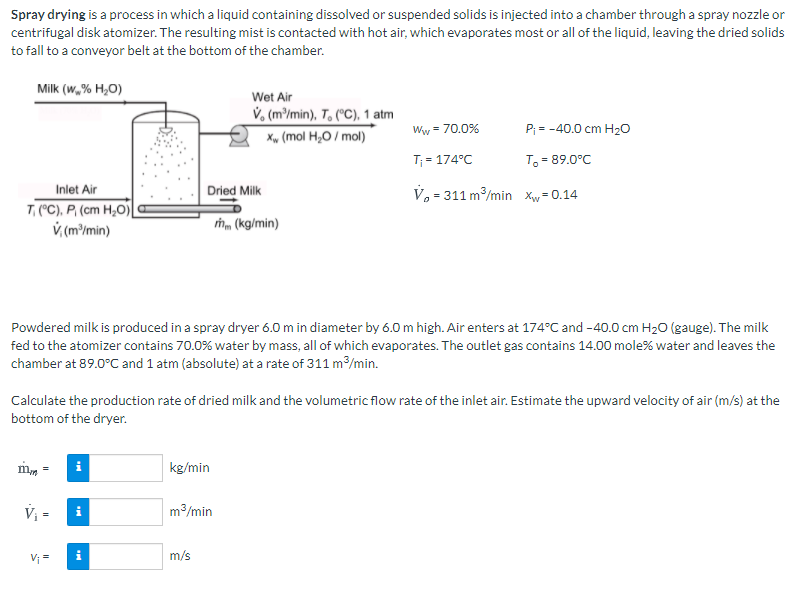Spray drying is a process in which a liquid containing dissolved or suspended solids is injected into a chamber through a spray nozzle or centrifugal disk atomizer. The resulting mist is contacted with hot air, which evaporates most or all of the liquid, leaving the dried solids to fall to a conveyor belt at the bottom of the chamber. Milk (w% H₂O) Wet Air V (m³/min), T (°C), 1 atm x (mol H₂O/mol) Ww=70.0% P₁ = -40.0 cm H₂O T₁ = 174°C V-311 m³/min x=0.14 To -89.0°C Inlet Air T (°C), P (cm H₂O)| V(m³/min) Dried Milk mm (kg/min) Powdered milk is produced in a spray dryer 6.0 m in diameter by 6.0 m high. Air enters at 174°C and -40.0 cm H2O (gauge). The milk fed to the atomizer contains 70.0% water by mass, all of which evaporates. The outlet gas contains 14.00 mole% water and leaves the chamber at 89.0°C and 1 atm (absolute) at a rate of 311 m³/min. Calculate the production rate of dried milk and the volumetric flow rate of the inlet air. Estimate the upward velocity of air (m/s) at the bottom of the dryer. m V₁ = kg/min m³/min m/s
Spray drying is a process in which a liquid containing dissolved or suspended solids is injected into a chamber through a spray nozzle or centrifugal disk atomizer. The resulting mist is contacted with hot air, which evaporates most or all of the liquid, leaving the dried solids to fall to a conveyor belt at the bottom of the chamber. Milk (w% H₂O) Wet Air V (m³/min), T (°C), 1 atm x (mol H₂O/mol) Ww=70.0% P₁ = -40.0 cm H₂O T₁ = 174°C V-311 m³/min x=0.14 To -89.0°C Inlet Air T (°C), P (cm H₂O)| V(m³/min) Dried Milk mm (kg/min) Powdered milk is produced in a spray dryer 6.0 m in diameter by 6.0 m high. Air enters at 174°C and -40.0 cm H2O (gauge). The milk fed to the atomizer contains 70.0% water by mass, all of which evaporates. The outlet gas contains 14.00 mole% water and leaves the chamber at 89.0°C and 1 atm (absolute) at a rate of 311 m³/min. Calculate the production rate of dried milk and the volumetric flow rate of the inlet air. Estimate the upward velocity of air (m/s) at the bottom of the dryer. m V₁ = kg/min m³/min m/s
Introduction to Chemical Engineering Thermodynamics
8th Edition
ISBN:9781259696527
Author:J.M. Smith Termodinamica en ingenieria quimica, Hendrick C Van Ness, Michael Abbott, Mark Swihart
Publisher:J.M. Smith Termodinamica en ingenieria quimica, Hendrick C Van Ness, Michael Abbott, Mark Swihart
Chapter1: Introduction
Section: Chapter Questions
Problem 1.1P
Related questions
Question

Transcribed Image Text:Spray drying is a process in which a liquid containing dissolved or suspended solids is injected into a chamber through a spray nozzle or
centrifugal disk atomizer. The resulting mist is contacted with hot air, which evaporates most or all of the liquid, leaving the dried solids
to fall to a conveyor belt at the bottom of the chamber.
Milk (w,% H,O)
Wet Air
v, (m³/min), T, ("C), 1 atm
Xu (mol H,O / mol)
Ww = 70.0%
P = -40.0 cm H20
T; = 174°C
T = 89.0°C
Inlet Air
Dried Milk
V, = 311 m/min Xw = 0.14
T (°C), P, (cm H,O)
V,(m³/min)
mm (kg/min)
Powdered milk is produced in a spray dryer 6.0 m in diameter by 6.0 m high. Air enters at 174°C and -40.0 cm H20 (gauge). The milk
fed to the atomizer contains 70.0% water by mass, all of which evaporates. The outlet gas contains 14.00 mole% water and leaves the
chamber at 89.0°C and 1 atm (absolute) at a rate of 311 m/min.
Calculate the production rate of dried milk and the volumetric flow rate of the inlet air. Estimate the upward velocity of air (m/s) at the
bottom of the dryer.
i
kg/min
V =
m/min
V; =
m/s
Expert Solution
This question has been solved!
Explore an expertly crafted, step-by-step solution for a thorough understanding of key concepts.
Step by step
Solved in 5 steps with 26 images

Recommended textbooks for you

Introduction to Chemical Engineering Thermodynami…
Chemical Engineering
ISBN:
9781259696527
Author:
J.M. Smith Termodinamica en ingenieria quimica, Hendrick C Van Ness, Michael Abbott, Mark Swihart
Publisher:
McGraw-Hill Education

Elementary Principles of Chemical Processes, Bind…
Chemical Engineering
ISBN:
9781118431221
Author:
Richard M. Felder, Ronald W. Rousseau, Lisa G. Bullard
Publisher:
WILEY

Elements of Chemical Reaction Engineering (5th Ed…
Chemical Engineering
ISBN:
9780133887518
Author:
H. Scott Fogler
Publisher:
Prentice Hall

Introduction to Chemical Engineering Thermodynami…
Chemical Engineering
ISBN:
9781259696527
Author:
J.M. Smith Termodinamica en ingenieria quimica, Hendrick C Van Ness, Michael Abbott, Mark Swihart
Publisher:
McGraw-Hill Education

Elementary Principles of Chemical Processes, Bind…
Chemical Engineering
ISBN:
9781118431221
Author:
Richard M. Felder, Ronald W. Rousseau, Lisa G. Bullard
Publisher:
WILEY

Elements of Chemical Reaction Engineering (5th Ed…
Chemical Engineering
ISBN:
9780133887518
Author:
H. Scott Fogler
Publisher:
Prentice Hall


Industrial Plastics: Theory and Applications
Chemical Engineering
ISBN:
9781285061238
Author:
Lokensgard, Erik
Publisher:
Delmar Cengage Learning

Unit Operations of Chemical Engineering
Chemical Engineering
ISBN:
9780072848236
Author:
Warren McCabe, Julian C. Smith, Peter Harriott
Publisher:
McGraw-Hill Companies, The